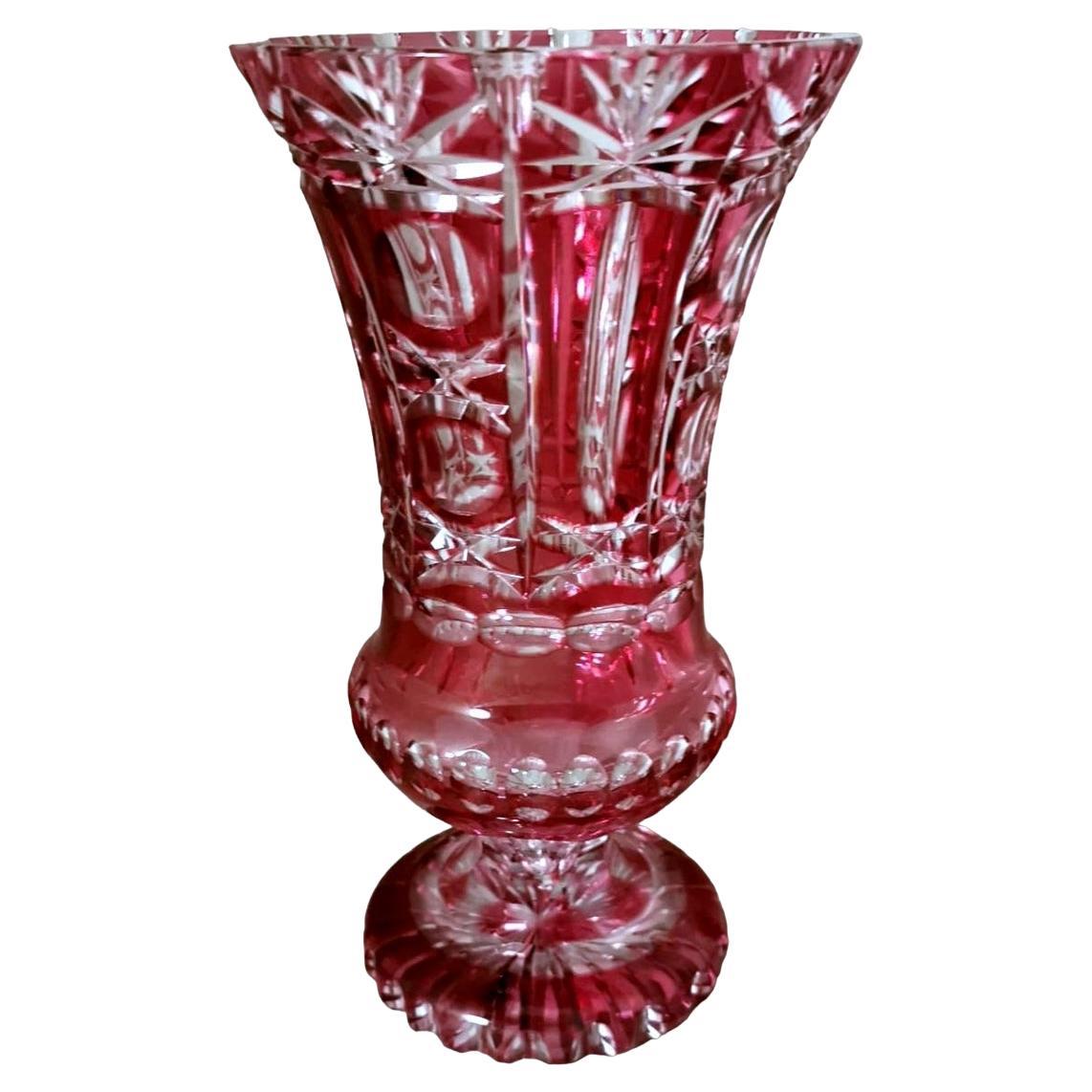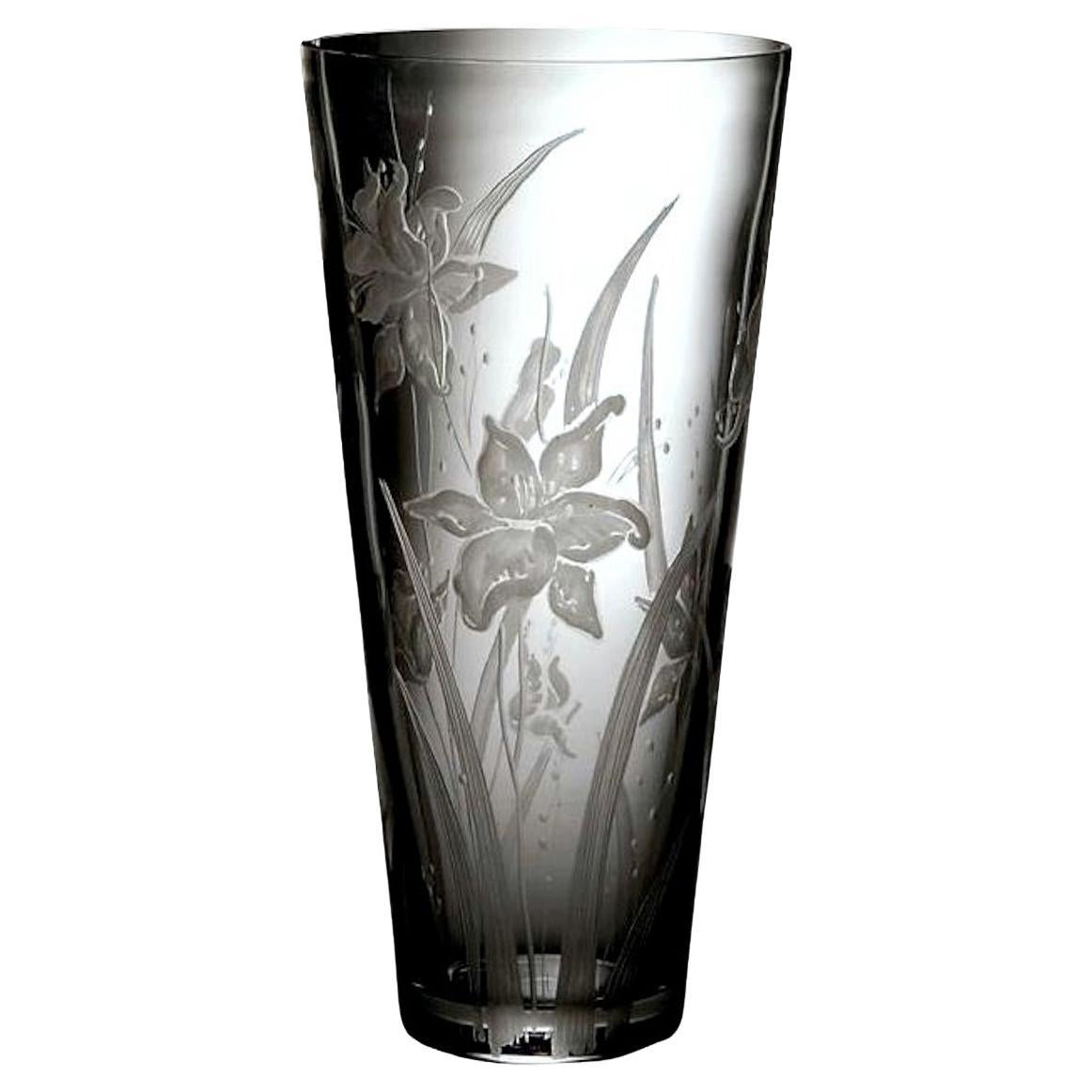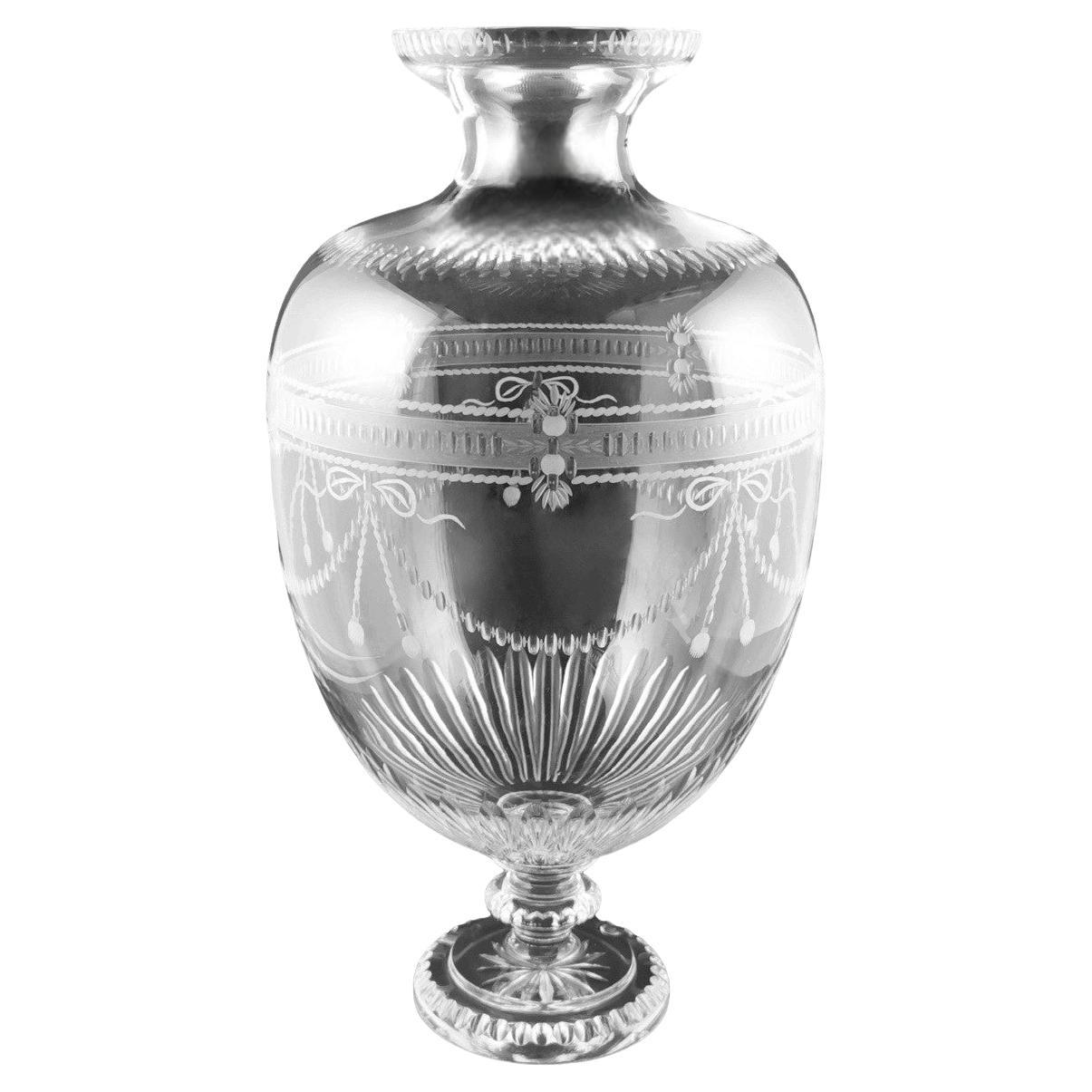Items Similar to Neoclassical Style Italian Chalice-Shaped Vase in Ground and Diamond Crystal
Want more images or videos?
Request additional images or videos from the seller
1 of 21
Neoclassical Style Italian Chalice-Shaped Vase in Ground and Diamond Crystal
About the Item
Before describing the object under consideration, we must make an important clarification; the artifact, one of many that we will publish over time, is part of the museum collection of a historic Florentine mill that unfortunately closed recently. It is the Marcello Galgani & Son company, whose completely manual and artisanal work has not withstood the disproportionate advance of mass-produced mechanical processes! Marcello Galgani began his craft as a grinder and restorer in 1960; as the years went by, Marcello mastered and became familiar with particular techniques and shapes, resulting in the production of objects that manage to retain the freshness of grinding and engraving, the warmth and softness of light, and the inimitable flavor of unique artifacts. After several years, his son Lorenzo, who grew up among crystals, also entered the business and immediately became passionate about this ancient craft with skill and ability. Stimulated by the aesthetic sense of the past, father and son, set up a workshop in which the shapes they researched and created themselves are mouth-blown by traditional Tuscan glassmakers in Empoli, then ground and engraved using ancient sixteenth-century techniques, with motifs born from the Galgani's inexhaustible imagination or culturally inspired by designs of objects seen and studied in Florentine museums (Uffizi, Galleria Palatina, Museo degli Argenti, etc.). Marcello and Lorenzo Galgani were also Masters in the difficult art of restoration, bringing rare and precious objects back to life. As mentioned the company recently closed and disposed of all its last production, and only Marcello's old private museum collection remained, which includes unique and special objects created over time, a collection that the craftsman made available to us for a planned sale. All of the objects were made entirely by hand with old grinding wheels, but there were mainly two tools that allowed the creation of masterpieces: the right hand and the left hand of the master craftsman. Ancient glassmaking techniques were used for all the ground and engraved products: first, the object was ground with an emery wheel fed continuously by a jet of abrasive sand and water, then re-polished with a very fine-grained sandstone wheel also fed with water; the engravings were done freehand using as many as 10-15 small stone wheels for each design (flowers, branches, animals, etc. ); then the object was polished and shined; we must make, at this point, an important clarification on these last two operations: towards the end of the 1960s acid crystal polishing was devised, the object was immersed and rotated in a solution of sulfuric acid, fluoridic acid and water and in a short time all the defects left by the previous processes were eliminated, it was a fast, industrial operation that allowed to lower costs considerably, with discrete but not excellent results. But for Galgani's products polishing is done with a cork bark wheel wet with water and pumice, to make the surfaces more transparent, and finally polishing was achieved with a felt wheel wet with a paste of water, iron oxide, and cerium oxide. This series of processes takes an average of two days of work( sometimes much longer) for each object, each engraving or grinding is the result of the creative inventiveness of the two artisans, inventiveness that transforms crystal into reality material of the highest aesthetic value and inestimable value. All the items in the entire collection have never been used; they were part of the exhibition. Large crystal vase in the shape of a chalice with a smooth round base; the delicate and pleasant decorations are in Neoclassical style; but the most important part is the diamond part in fact normally the diamond polishing was done by machine or a pre-printed diamond on the object was polished, on this vase it was done completely by hand with an amazing and extraordinary result! The object is "a unique piece" signed by the Master, it was executed in Marcello Galgani's workshop in 1985 and made with the techniques (grinding, engraving, and polishing) that we have explained in the introductory description; for the shape, the Master was inspired by some vases of ancient Bohemian manufacture preserved at the Bargello Museum in Florence, however, he personalized his vase creating a rare and precious object. Measures diameter cm.16, height cm.43. The vase is in excellent condition. For all our shipments we use special packaging materials (wooden crates, Styrofoam, etc.) for maximum protection and safety of the objects
- Dimensions:Height: 16.93 in (43 cm)Diameter: 6.3 in (16 cm)
- Style:Neoclassical (In the Style Of)
- Materials and Techniques:
- Place of Origin:
- Period:
- Date of Manufacture:1985
- Condition:The vase is in excellent condition. All the items in the entire collection have never been used; they were part of the exhibition.
- Seller Location:Prato, IT
- Reference Number:
About the Seller
5.0
Platinum Seller
These expertly vetted sellers are 1stDibs' most experienced sellers and are rated highest by our customers.
Established in 1977
1stDibs seller since 2019
234 sales on 1stDibs
Typical response time: 2 hours
- ShippingRetrieving quote...Ships From: PRATO, Italy
- Return PolicyA return for this item may be initiated within 14 days of delivery.
More From This SellerView All
- Neoclassical Style Italian Crystal Vase With Festoon EngravingsLocated in Prato, TuscanyBefore describing the object under consideration we must make an important clarification; the artifact, one of many that we will publish over time, is part of the museum collection o...Category
Late 20th Century Italian Neoclassical Vases
MaterialsCrystal
- Florentine Renaissance Style Huge Italian Cut And Ground Crystal Medici VaseLocated in Prato, TuscanyBefore describing the object under consideration, we must make an important clarification; the artifact, one of many that we will publish over time, is part of the museum collection of a historic Florentine mill that unfortunately closed recently. It is the Marcello Galgani & Son company, whose completely manual and artisanal work has not withstood the disproportionate advance of mass-produced mechanical processes! Marcello Galgani began his craft as a grinder and restorer in 1960; as the years went by, Marcello mastered and became familiar with particular techniques and shapes, resulting in the production of objects that manage to retain the freshness of grinding and engraving, the warmth and softness of light, and the inimitable flavor of unique artifacts. After several years, his son Lorenzo, who grew up among crystals, also entered the business and immediately became passionate about this ancient craft with skill and ability. Stimulated by the aesthetic sense of the past, father and son, set up a workshop in which the shapes they researched and created themselves are mouth-blown by traditional Tuscan glassmakers in Empoli, then ground and engraved using ancient sixteenth-century techniques, with motifs born from the Galgani's inexhaustible imagination or culturally inspired by designs of objects seen and studied in Florentine museums (Uffizi, Galleria Palatina, Museo degli Argenti, etc.). Marcello and Lorenzo Galgani were also Masters in the difficult art of restoration, bringing rare and precious objects back to life. As mentioned the company recently closed and disposed of all its last production, and only Marcello's old private museum collection remained, which includes unique and special objects created over time, a collection that the craftsman made available to us for a planned sale. All of the objects were made entirely by hand with old grinding wheels, but there were mainly two tools that allowed the creation of masterpieces: the right hand and the left hand of the master craftsman. Ancient glassmaking techniques were used for all the ground and engraved products: first, the object was ground with an emery wheel fed continuously by a jet of abrasive sand and water, then re-polished with a very fine-grained sandstone wheel also fed with water; the engravings were done freehand using as many as 10-15 small stone wheels for each design (flowers, branches, animals, etc. ); then the object was polished and shined; we must make, at this point, an important clarification on these last two operations: towards the end of the 1960s acid crystal polishing was devised, the object was immersed and rotated in a solution of sulfuric acid, fluoridic acid and water and in a short time all the defects left by the previous processes were eliminated, it was a fast, industrial operation that allowed to lower costs considerably, with discrete but not excellent results. But for Galgani's products polishing is done with a cork bark wheel wet with water and pumice, to make the surfaces more transparent, and finally polishing was achieved with a felt wheel wet with a paste of water, iron oxide, and cerium oxide. This series of processes takes an average of two days of work( sometimes much longer) for each object, each engraving or grinding is the result of the creative inventiveness of the two artisans, inventiveness that transforms crystal into reality material of the highest aesthetic value and inestimable value. All the items in the entire collection have never been used; they were part of the exhibition. Huge and monumental Florentine Renaissance-style vase...Category
Late 20th Century Italian Renaissance Vases
MaterialsCrystal
- Biedermeier Style Bohemia Cut And Ground Red Crystal VaseLocated in Prato, TuscanyWe kindly suggest that you read the entire description, as with it we try to give you detailed technical and historical information to ensure the authenticity of our objects. Delight...Category
Mid-20th Century Czech Biedermeier Vases
MaterialsCrystal
- Italian Cut And Ground Crystal Vase With Flower DecorationLocated in Prato, TuscanyBefore describing the object under consideration we must make an important clarification; the artifact, one of many that we will publish over time, is part of the museum collection o...Category
Late 20th Century Italian Mid-Century Modern Vases
MaterialsCrystal
- Neoclassical Style Large Italian Crystal Vase with 18th Century EngravingsLocated in Prato, TuscanyBefore describing the object under consideration, we must make an important clarification; the artifact, one of many that we will publish over time, is part of the museum collection ...Category
Late 20th Century Italian Neoclassical Vases
MaterialsCrystal
- Art Deco French Vase in Cut and Ground Yellow CrystalLocated in Prato, TuscanyWe kindly suggest that you read the entire description, as with it we try to give you detailed technical and historical information to guarantee the authenticity of our objects. Ori...Category
Mid-20th Century French Art Deco Vases
MaterialsCrystal
You May Also Like
- Italian Neoclassical 19th Century Black-Ground Terracotta VaseLocated in Rome, ITElegant Italian 19th century neoclassical black painted terracotta vase after the original Roman marble vase. Bordered center body decorated with styl...Category
Antique 19th Century Italian Grand Tour Vases
MaterialsTerracotta
- Italian Neoclassical Style Pair of Rock Crystal and Bronze TazzasLocated in Cypress, CAItalian neoclassical style pair of hand-carved and hand polished rock crystal and gilt bronze tazzas, mid-20th century. Base measurement is 4.25 inches x 4.25 inches.Category
Mid-20th Century Italian Neoclassical Urns
MaterialsRock Crystal, Bronze
- Large Neoclassical Alabaster Campagna-Shaped VaseLocated in London, GBA large alabaster campagna-shaped vase Continental, 20th century Measures: Height 34.5cm, diameter 24cm In a distilled neoclassical style in the so-called campagna shape, this fine vase is made from alabaster, a fine-grained, white, and lightly tinted type of gypsum. It was made as mineral specimen vase...Category
20th Century European Neoclassical Vases
MaterialsAlabaster
- Pair of French 19th Century Neoclassical Style Ormolu and Crystal VasesLocated in West Palm Beach, FLA striking pair of French 19th century neo-classical st. ormolu and Baccarat crystal vases. Each vase is raised by an elegant square base with a reeded wrap around ormolu band and scrolled palmettes feet. The beautiful crystal vases...Category
Antique 19th Century French Neoclassical Vases
MaterialsCrystal, Ormolu
- Pair of 19th Century Neoclassical Style Baccarat Crystal and Ormolu VasesLocated in West Palm Beach, FLA handsome and statement making pair of French 19th century Neo-Classical st. Baccarat crystal and ormolu vases. Each vase is raised by an elegant square ormolu base with a fine mott...Category
Antique 19th Century French Neoclassical Vases
MaterialsCrystal, Ormolu
- Large Light Amber Italian Cut & Etched Glass Chalice Shaped Vase or CenterpieceLocated in Hamilton, OntarioThis very large and substantial light amber art glass vase is unsigned, but presumed to originate from Italy and dating to approximately 1950 and done in a Renaissance Revival style....Category
Mid-20th Century Italian Renaissance Revival Vases
MaterialsCut Glass
Recently Viewed
View AllMore Ways To Browse
Vintage Furniture Before And After
Crystal Sale
Italian Style Furniture For Sale
Ancient Crystals
Diamond Shaped Crystal
Neoclassical Design Light
Vintage Style Crates
Vintage Style Crate
Retro Industrial Bathroom
Vintage Industrial Industrial Style Bathroom
Shorter And Sons
Old Vintage Craftsman
Vintage Craftsman Bathroom
Large Iron Vase
Retro Craftsman Bathroom
Vintage Inspired Bathroom
Vintage Inspired Bathrooms
Artifact Light





